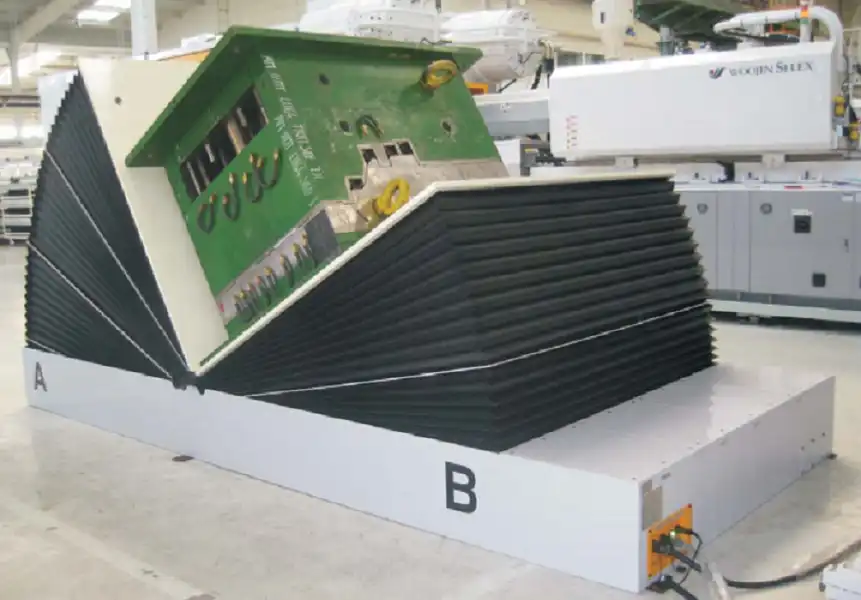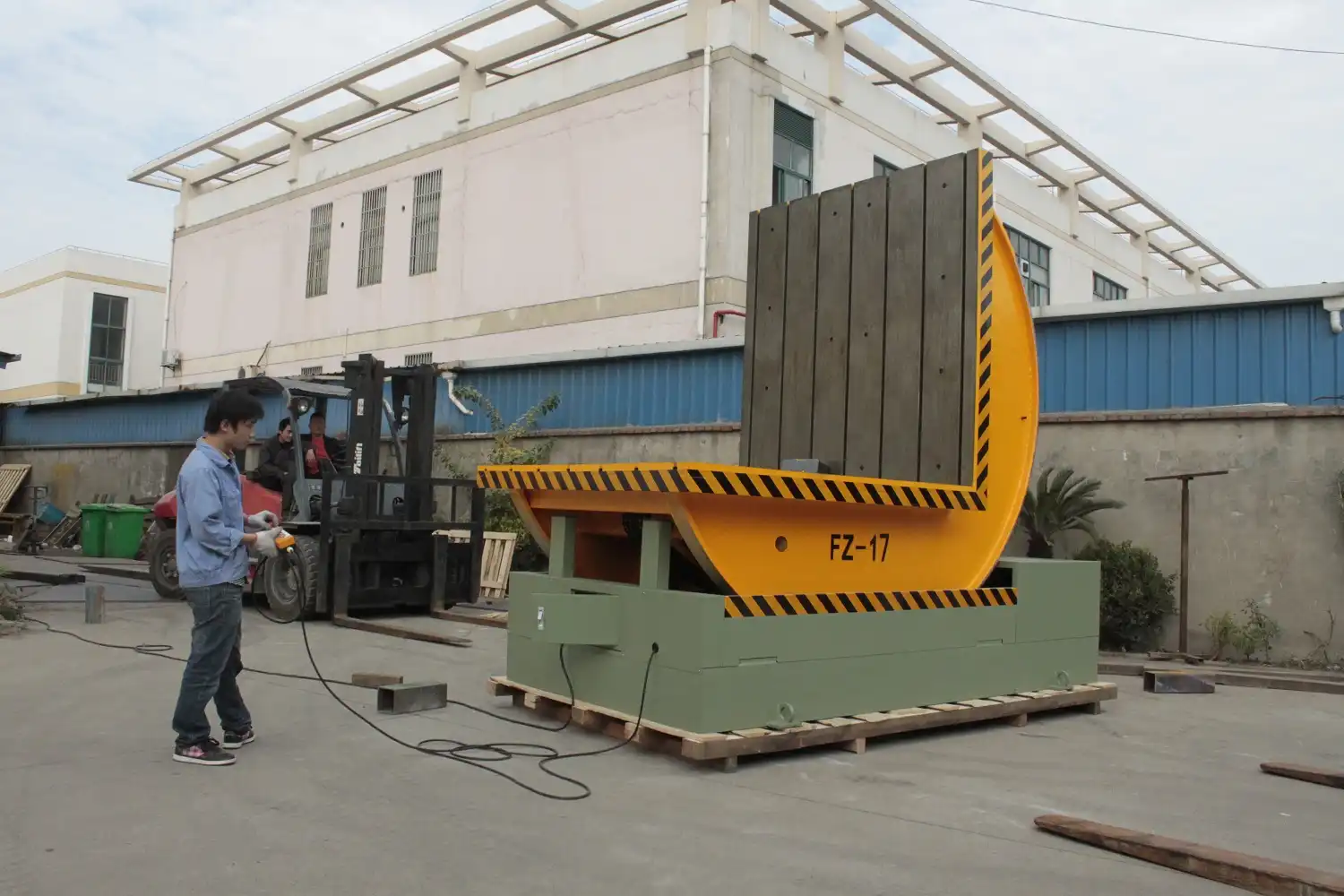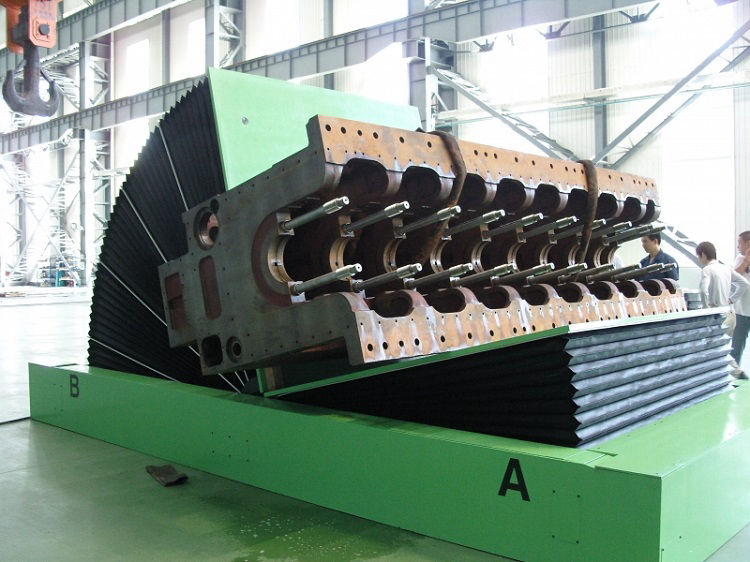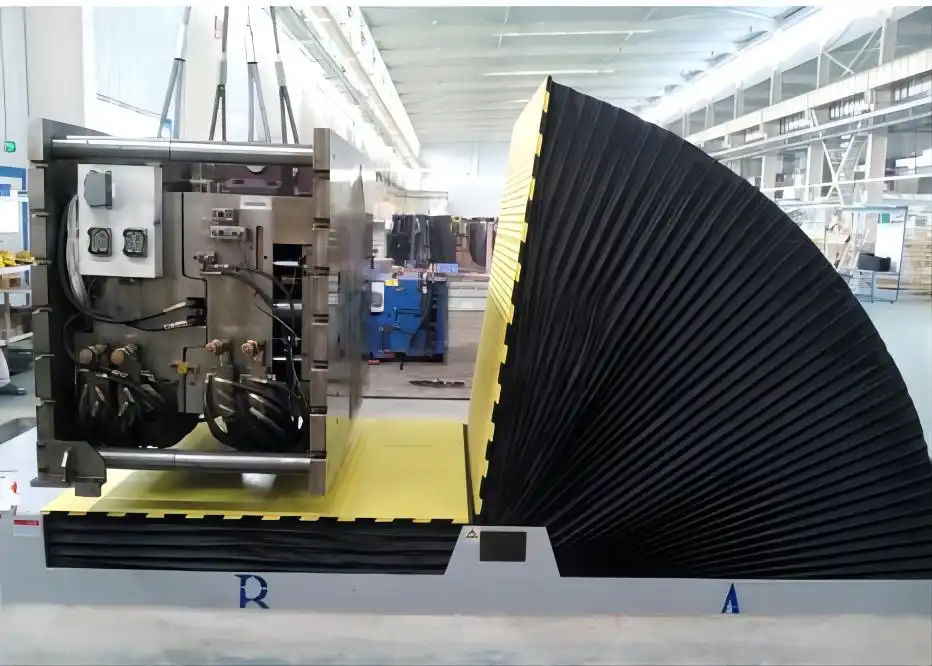Mold Flipper: How to Align Safety Procedures with Malaysia Plant Practices?
You have invested in a powerful mold flipper for your Malaysian plant. But integrating it safely can feel like solving a complex puzzle. Local regulations, existing worker habits, and the machine's safety manual seem to speak different languages. A single misstep can lead to serious accidents, costly downtime, and regulatory fines. This gap between machine specifications and real-world plant practices creates a constant risk. You may wonder if your operators are truly prepared. Or if your safety procedures are robust enough to satisfy Malaysia's DOSH (Department of Occupational Safety and Health) requirements. The pressure is on to ensure compliance without slowing down production. Aligning these two worlds is not just possible; it is essential. It requires a clear, structured approach. This approach combines understanding local regulations, conducting thorough risk assessments, and implementing practical training. I have been through this process many times with clients and in my own factory. I can guide you through it.
Aligning mold flipper safety with Malaysian plant practices requires a three-step approach. First, understand and document Malaysia's DOSH regulations specific to heavy machinery. Second, conduct a detailed risk assessment that considers both the machine's functions and your specific plant environment. Third, develop and implement customized Standard Operating Procedures (SOPs) and training programs in the local language, ensuring every operator understands the risks and safety measures.

This process might sound complex, but breaking it down makes it manageable. It is about building a bridge between the machine's technical manual and the human element in your factory. Let's explore the key steps to build that bridge. We can create a truly safe working environment. I will share what I have learned from my years as an engineer and factory owner. This journey helped me achieve financial independence and help my clients grow. Now, I want to share that knowledge with you.
What are the core safety standards for mold flippers in Malaysia?
Navigating the legal landscape for industrial machinery in Malaysia can be daunting. You know there are rules. But finding the specific standards for a machine like a mold flipper can feel like searching for a needle in a haystack. Ignoring or misinterpreting these regulations from the Department of Occupational Safety and Health (DOSH) is not an option. It can lead to severe penalties, work stoppages, and, most importantly, put your team at risk. As a business owner, you cannot afford to guess when it comes to safety and compliance. The key is to focus on the core principles outlined in two main pieces of legislation. These are the Occupational Safety and Health Act (OSHA) 1994 and the Factories and Machinery Act (FMA) 1967. These acts provide the foundational framework for all machinery safety, including your new mold flipper.
The core safety standards for mold flippers in Malaysia are governed by the Occupational Safety and Health Act (OSHA) 1994 and the Factories and Machinery Act (FMA) 1967. These require employers to provide a safe work environment, conduct risk assessments (HIRARC), ensure machinery is properly guarded and maintained, and provide adequate operator training and supervision.

Diving into Malaysian Safety Legislation
Understanding these acts is the first step toward building a compliant safety program. They are not just documents to be filed away. They are active guides for your day-to-day operations. Let's break down what they mean for your plant.
The Occupational Safety and Health Act (OSHA) 1994
This is the principal legislation for occupational safety in Malaysia. Its philosophy is based on self-regulation. This means the primary responsibility for ensuring safety lies with the people who create and manage the risks. For a steel mill owner like yourself, this is critical. Under OSHA 1994, your duties are clear. You must provide and maintain a safe plant and systems of work. You must make arrangements for the safe use, handling, storage, and transport of equipment like your mold flipper. A key requirement of OSHA is the Hazard Identification, Risk Assessment, and Risk Control (HIRARC) process. This is a systematic way to identify potential dangers, assess their severity, and implement controls. For a mold flipper, this would involve looking at everything from pinch points and crush zones to hydraulic system integrity and electrical safety.
The Factories and Machinery Act (FMA) 1967
While OSHA 1994 is broader, the FMA 1967 is more prescriptive about machinery itself. It contains specific regulations regarding the safety, health, and welfare of persons in relation to the operation of factories and machinery. For your mold flipper, this act dictates requirements for:
- Machine Guarding: All dangerous parts, like gears, chains, and rotating components, must be securely fenced or guarded.
- Certification: Certain types of machinery require a certificate of fitness (CF) from DOSH before they can be operated. You must verify if your mold flipper falls into this category.
- Maintenance and Inspection: The act mandates regular maintenance and inspection by a competent person. Keeping detailed logs is not just good practice; it is a legal requirement.
Here is a simple breakdown of responsibilities under these acts:
| Responsibility Area | Employer's Duty (Your Role) | Employee's Duty (Operator's Role) |
|---|---|---|
| Safe Equipment | Provide a certified, well-maintained mold flipper with all safety guards in place. | Do not operate the machine if safety guards are missing or damaged. Report faults immediately. |
| Risk Assessment | Conduct and document a thorough HIRARC for all mold flipping tasks. | Participate in the HIRARC process by providing feedback on real-world risks. |
| Training | Provide comprehensive training on SOPs, emergency procedures, and hazards. | Attend and actively participate in all training. Follow all safety instructions. |
| Safe Environment | Ensure clear, well-lit work areas with no obstructions around the machine. | Maintain good housekeeping in the work area. Do not create new hazards. |
By understanding and applying these two acts, you are not just ticking a compliance box. You are building the foundation for a stable, predictable, and safe production environment. This directly supports your goal of improving uptime and reducing operational risks.
How can you conduct a practical risk assessment for mold flipper operations?
A generic risk assessment checklist from the internet is not enough. Your plant, your molds, and your workflow are unique. A one-size-fits-all approach misses critical, site-specific hazards that could be hiding in plain sight. This oversight can create a false sense of security. An unaddressed hazard in the mold flipping process, like an uneven floor, improper rigging techniques, or an unexpected power fluctuation, could lead to a catastrophic failure. Imagine the damage to a multi-ton mold, the production halt, and the potential for serious injury. A practical risk assessment must be a hands-on process. It involves observing the entire operation from start to finish. You need to watch how the mold is transported, how it is loaded onto the flipper, the flipping cycle itself, and the maintenance procedures. Most importantly, you must talk to the operators who perform this work every day. They are your best source for uncovering the real, practical risks.
To conduct a practical risk assessment for a mold flipper, you must follow the HIRARC model mandated by DOSH. First, identify all potential hazards in the entire process, including mechanical, electrical, and human factors. Next, assess the risk level of each hazard by considering its likelihood and severity. Finally, implement concrete control measures, prioritizing engineering controls over simple reliance on personal protective equipment (PPE).

A Step-by-Step Guide to HIRARC for Your Mold Flipper
The HIRARC process is the gold standard in Malaysia for a reason. It is logical and effective. When I work with clients, I emphasize that this is not a paperwork exercise. It is a practical tool for making the workplace safer. Let's walk through how to apply it specifically to your mold flipper.
Step 1: Hazard Identification (HI)
Gather a small team. It should include a safety officer, a maintenance engineer, and at least one experienced mold flipper operator. Walk through the entire process and brainstorm every possible thing that could go wrong. Think in categories:
- Mechanical Hazards: Pinch points between the mold and machine, crush zones underneath the load, failure of lifting chains or straps, hydraulic hose rupture.
- Electrical Hazards: Exposed wiring, control panel malfunction, unexpected startup after a power outage.
- Ergonomic Hazards: Awkward postures for operators during loading/unloading, repetitive motions.
- Environmental Hazards: Slippery floors from oil leaks, poor lighting that obscures vision.
- Human Factor Hazards: Operator distraction, lack of communication, use of shortcuts, insufficient training.
Step 2: Risk Assessment (RA)
For each hazard you identified, you need to assess its risk level. A simple way is to use a risk matrix. You rate the likelihood of the hazard occurring and the severity of the potential outcome. For example, a hydraulic hose rupture might be 'Unlikely' but its severity would be 'Catastrophic'. This helps you prioritize.
| Hazard Example | Likelihood (1-5) | Severity (1-5) | Risk Score (L x S) |
|---|---|---|---|
| Pinch Point at Clamp | 4 (Likely) | 4 (Major Injury) | 16 (High Risk) |
| Hydraulic Hose Rupture | 2 (Unlikely) | 5 (Catastrophic) | 10 (Medium Risk) |
| Operator Slip on Oil | 3 (Possible) | 2 (Minor Injury) | 6 (Low Risk) |
Step 3: Risk Control (RC)
This is the most important step. Based on your risk scores, you implement controls using the Hierarchy of Controls. You must prioritize the most effective methods first.
- Elimination: Can the hazard be removed completely? (e.g., Automating the clamping process to remove the need for hands near pinch points).
- Substitution: Can you replace the hazard with something safer? (e.g., Using higher-rated lifting chains).
- Engineering Controls: Can you physically isolate people from the hazard? This is where SHJLPACK focuses. Our machines include features like light curtains that stop the machine if someone enters the danger zone, interlocked gates, and robust hydraulic fail-safes.
- Administrative Controls: How can you change the way people work? This includes developing clear SOPs, installing warning signs, and implementing lockout-tagout (LOTO) procedures for maintenance.
- Personal Protective Equipment (PPE): This is the last line of defense. It includes safety shoes, hard hats, and gloves. PPE is essential, but it should never be the only control measure.
I remember a client in Johor Bahru who had issues with their old tilter. The HIRARC process revealed that operators were standing too close during operation. We implemented a simple but effective engineering control: we painted a clear "Exclusion Zone" on the floor and linked the machine's start button to a pressure mat outside this zone. The operator had to be in a safe position to start the cycle. This practical solution, born from a proper risk assessment, drastically improved their safety.
What training protocols are essential for safe mold flipper use in a Malaysian plant?
You can have the best machine in the world and a detailed safety manual. But if your operators are unsure or, even worse, develop unsafe shortcuts, your investment is at risk. The machine itself cannot be safe if the people using it are not properly and thoroughly trained. This training gap is where most accidents originate. An operator might not fully understand the mold's center of gravity, misinterpret a warning light on the control panel, or fail to perform a crucial pre-use check. These small omissions can lead to preventable incidents that halt production, damage expensive equipment, and endanger your team. Effective training is much more than just handing someone a manual. It is about hands-on practice, clear communication in the local language, and continuous reinforcement of safe habits until they become second nature. A certified and well-documented training program is your best defense against human error.
Essential training protocols for mold flipper use include three key stages. First, theoretical classroom-style training on the machine's operation, its specific safety features, and the local DOSH regulations. Second, supervised, hands-on practice with different mold sizes and weights to build real-world skill and confidence. Third, a formal certification process to verify competency, followed by regular refresher courses to ensure knowledge does not fade over time.

Building a Robust Training Program
A structured training program turns novices into competent, safety-conscious operators. In my years of commissioning machines, I have seen firsthand what works. A comprehensive program should be built on several pillars, ensuring no aspect of safe operation is left to chance. This approach not only meets Malaysian legal requirements but also supports your goal of achieving 95% equipment uptime by minimizing operator-induced errors and downtime.
Phase 1: Theoretical and Classroom Training
This is the foundation. Before anyone touches the machine, they must understand the principles behind it. This session should be interactive, not a boring lecture.
- Machine-Specific Knowledge: Cover the user manual in detail. Explain every button, switch, and warning light on the control panel. Discuss the machine's capacity limits, speed settings, and the function of its safety systems (e.g., E-stops, light curtains, hydraulic valves).
- SOPs and Safe Work Practices: Go through your company's Standard Operating Procedures for mold flipping step-by-step. This includes pre-operation checks, proper rigging and slinging techniques for different mold types, and communication protocols with crane operators or forklift drivers.
- Emergency Procedures: What should an operator do if the machine stops mid-cycle? Or if a hydraulic leak occurs? Role-playing these scenarios in a classroom setting builds preparedness.
- Language and Culture: In a Malaysian plant, this training must be delivered in a language operators understand, whether it is Bahasa Melayu, English, or another language. Using visuals and simple terms is key.
Phase 2: Supervised, Hands-On Practice
Theory is nothing without practice. This phase must be conducted by an experienced supervisor or trainer.
- Demonstration: The trainer should first demonstrate the entire process with a real mold, explaining each step as they go.
- Guided Practice: The trainee then operates the machine under close supervision, starting with smaller, less complex molds. The supervisor provides real-time feedback and correction.
- Problem-Solving: Intentionally create minor, safe "problems" for the trainee to solve. For example, asking them to demonstrate the E-stop procedure or what to do if a limit switch is not engaged.
Phase 3: Competency Assessment and Certification
You need to verify that the training was effective.
- Practical Test: The operator must demonstrate their ability to safely operate the mold flipper through a complete cycle without supervision or assistance.
- Written or Oral Test: A simple quiz to confirm their understanding of safety rules, load limits, and emergency actions.
- Formal Certification: Once they pass, issue a formal, documented certification or license to operate. Keep a record of this for DOSH compliance and your own internal records.
| Training Component | Key Objective | Documentation Required |
|---|---|---|
| Classroom Session | Understand the 'why' behind safety rules and machine functions. | Attendance sheet, training materials. |
| Practical Training | Develop muscle memory and practical skills for safe operation. | Supervisor's log of trainee's performance. |
| Assessment | Verify that the trainee has achieved the required level of competency. | Signed competency assessment form, test results. |
| Refresher Course | Combat skill fade and update on new procedures. (Annually recommended). | Record of refresher training completion. |
This systematic approach ensures every operator has the knowledge and skill to be a partner in safety, not a liability.
What is my personal take on achieving synergy between machine safety and plant culture?
You can have all the right procedures. You can have the most advanced safety features, like light curtains and interlocks, on your mold flipper. But if safety is not part of your company's DNA, your efforts will fall flat. Procedures will be ignored. A "get it done quick" attitude will take over. I have seen this happen. This cultural disconnect is frustrating for any leader. You invest significant capital in safe equipment and training, but you still see near-misses or minor incidents. It feels like a constant battle between management's safety goals and the reality on the factory floor. The machine itself is often blamed, when the real issue is the human system surrounding it. From my own journey, starting as a hands-on engineer and later establishing my own factory, I learned a powerful lesson. True safety is not a department, a poster, or a manual. It is a shared value that must be lived every day, from the CEO to the newest hire. It comes from visible leadership commitment, empowering your team, and making safety a non-negotiable part of every single task.
My personal take is that synergy between machine safety and plant culture is achieved when leadership treats safety as a core business value, not just a compliance issue. This means visibly championing safety in every meeting, empowering any operator to stop work if they feel unsafe without fear of reprisal, and integrating safety metrics into performance reviews with the same weight as production targets.

From Engineer to Owner: My Shift in Perspective
When I was a young engineer, my focus was on the machine. I wanted to design the strongest, most efficient, and most reliable coil wrappers and flippers possible. I was proud of the engineering, the steel, and the hydraulics. But when I started my own factory, SHJLPACK, my perspective had to change. I was no longer just responsible for the machine; I was responsible for the people operating it. This is a profound shift that I am sure you, Javier, have experienced in your own journey to becoming a steel mill owner. A machine is predictable. People are not. This is where culture becomes more important than engineering.
Leadership Drives the Culture
Safety culture starts at the very top. It is not something you can delegate and forget. I learned that my actions spoke louder than any memo. I made it a point to walk the factory floor every day. I did not just look at production numbers. I looked for safety hazards. I talked to operators about their concerns. I wore the same PPE I expected them to wear. When we had a near-miss, we did not look for someone to blame. We treated it as a learning opportunity. We held a team meeting, analyzed the root cause, and publicly thanked the person who reported it. As a leader, you must make safety personal and visible. When your team sees that you care deeply about their well-being, they start to care more, too.
Empowering the Operator
The person standing at the controls of the mold flipper knows more about its real-world risks than anyone in an office. You must empower that person. This means creating a 'no-blame' culture where anyone can raise a safety concern or even hit the emergency stop without fear. In my factory, we have a simple rule: "If you see something unsafe, you own it until it is fixed." This gives operators the authority and responsibility to be safety leaders in their own areas. We established clear channels for feedback, from simple suggestion boxes to regular safety team meetings where operators are the main speakers. Rewarding proactive safety behavior—like identifying a potential hazard before it causes a problem—is far more effective than punishing mistakes after the fact.
Making Safety Visible and Measured
As a results-oriented leader, you know that what gets measured gets managed. You track tons produced, energy costs, and profit margins. You must track safety with the same rigor.
- Leading Indicators: Track things like the number of safety observations reported, training sessions completed, and safety audits passed. These are proactive measures.
- Lagging Indicators: Track near-misses, first-aid incidents, and lost-time injuries. Analyze these trends to find weak spots in your system.
Discuss these safety metrics in every production meeting. Put them on a board for everyone to see. When safety is discussed with the same seriousness as output and quality, it sends a clear message: it is a core part of the business. For a leader like yourself, aiming to reduce operational costs by 8%, a strong safety culture is not an expense. It is a high-return investment that pays dividends by preventing costly accidents, fines, and downtime.
Conclusion
Aligning mold flipper safety with Malaysian practices integrates regulations, risk assessment, and training. This creates a secure, efficient, and compliant operation for your long-term success and profitability.





